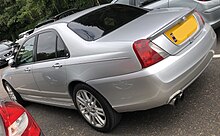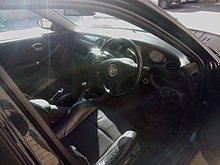
A V6 engine is a six-cylinder piston engine where the cylinders share a common crankshaft and are arranged in a V configuration.

MG Rover Group was the last domestically owned mass-production car manufacturer in the British motor industry. The company was formed when BMW sold the car-making and engine manufacturing assets of the original Rover Group to Phoenix Venture Holdings in 2000.

The Rover Group plc was the British vehicle manufacturing conglomerate known as "BL plc" until 1986, which had been a state-owned company since 1975. It initially included the Austin Rover Group car business, Land Rover Group, Freight Rover vans and Leyland Trucks. The Rover Group also owned the dormant trademarks from the many companies that had merged into British Leyland and its predecessors such as Triumph, Morris, Wolseley, Riley and Alvis.
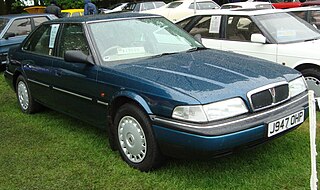
The Rover 800 series is an executive car range manufactured by the Austin Rover Group subsidiary of British Leyland, and its successor the Rover Group from 1986 to 1999. It was also marketed as the Sterling in the United States. Co-developed with Honda, it was a close relative to the Honda Legend and the successor to the decade-old Rover SD1.

The Land Rover Freelander is a compact SUV that was manufactured and marketed by Land Rover from 1997 to 2015. The second generation was sold from 2007 to 2015 in North America and the Middle East as the LR2 and in Europe as the Freelander 2. The Freelander was sold in both two-wheel and four-wheel drive versions. The name 'Freelander' is derived from the combination of 'Freedom' and 'Lander'.

The Rover V8 engine is a compact V8 internal combustion engine with aluminium cylinder block and cylinder heads, originally designed by General Motors and later re-designed and produced by Rover in the United Kingdom. It has been used in a wide range of vehicles from Rover and other manufacturers since its British debut in 1967.

The Rover 75 is a car which was manufactured from 1998 to 2005 and sold under the British Rover marque. It is a large family car and came in four-door saloon and five-door estate body styles. Initially built only with front-wheel drive, a rear-wheel drive variant with a V8 engine was later sold. There was also an extended-wheelbase model. In 2001, MG Rover launched a badge engineered variant, the MG ZT. A coupé concept was built, but did not receive further development.

The Rover 400 Series, and later the Rover 45, are a series of small family cars that were produced by the British manufacturer Rover from 1990 to 2005. The cars were co-developed as part of Rover's collaboration with Honda. The first-generation 400 was based on the Honda Concerto, and the Mark II 400 was based on the Honda Domani/Civic.
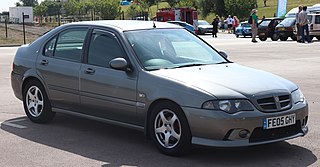
The MG ZS is a sports family car that was built by MG Rover from 2001 until 2005. The ZS is essentially a tuned version of the Rover 45. The 45 in turn is a facelifted version of the Rover 400 which was launched in hatchback form in 1995 and saloon form in 1996, which in turn was derived from the Honda Domani.

The MG XPower SV is a sports car that was produced by British automobile manufacturer MG Rover. Manufactured in Modena, Italy and finished at Longbridge, United Kingdom, it was based on the platform of the Qvale Mangusta, formerly the De Tomaso Biguà, itself using parts from the Ford Mustang.

The MG F and MG TF are mid-engined, rear wheel drive roadster cars that were sold under the MG marque by three manufacturers between 1995 and 2011.

The LDV Pilot is a panel van that was produced by LDV Limited from 1996 until 2005, and closely based on preceding models dating back to the 1974 Leyland Sherpa developed by the Austin-Morris division of British Leyland, which was in turn derived from earlier light commercials produced by the British Motor Corporation.

The KV6 automotive petrol engine has a 24-valve quad-cam V6 configuration, and a pressurising variable-length intake manifold to add hot spots throughout the rev range. Variants exist in 2.0 to 2.5 litres capacities. These were built initially by Rover Group, then by Powertrain Ltd. KIA manufactured KV6 in Korea under licence. Production moved from the UK to China in 2005, re-designated NV6.
1998 in motoring includes developments in the automotive industry that occurred throughout the year 1998 by various automobile manufacturers, grouped by country. The automotive industry designs, develops, manufactures, markets, and sells motor vehicles.
This article 2001 in motoring deals with developments in the automotive industry that occurred throughout the year 2001 by various automobile manufacturers, grouped by country.

The MG7 is a mid-size sedan that was built by MG Motor between 2007 and 2013, derived from its British predecessors, Rover 75 and MG ZT to suit Chinese manufacturing and sales. The name was resurrected in 2022 with the launch of the second generation MG7.
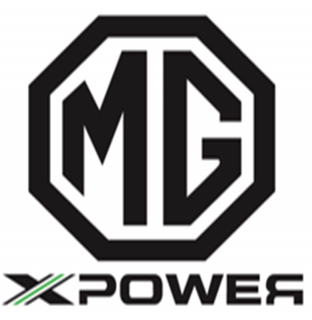
MG XPower is a British automotive brand created by MG Rover Group in 2001 and now owned by MG Sports and Racing Europe, based in Tenbury Wells.

The MG6 is a compact car which has been produced by Chinese manufacturer SAIC Motor under the MG marque since 2010. It is slotted slightly above the compact sedan MG GT, and the compact hatchback MG 5.
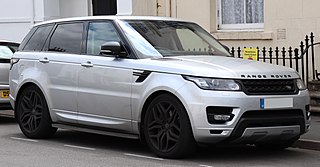
The Land Rover Range Rover Sport, generally known as the Range Rover Sport, is a mid-size luxury SUV produced under their Land Rover marque, from the British manufacturer Land Rover, and later Jaguar Land Rover. The first generation started production in 2005, and was replaced by the second generation Sport in 2013, replaced by the third generation Sport in 2022.
The Austin Drawing Office was the design and engineering department of the British Motor Corporation. From the early 1950s, the resulting projects of the office were known by the initials ADO. The numbers were assigned to vehicle and engineering projects, some resulting in production models. The ADO numbering system continued well beyond BMC's absorption into British Leyland, who continued to use the convention until the late 1970s.

